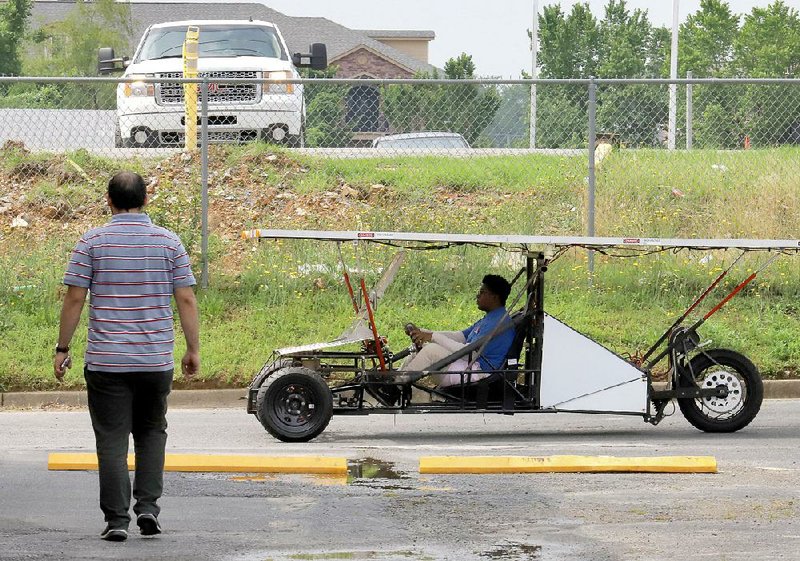What has three motorcycle wheels, all-terrain vehicle arms, four batteries, and a motor -- all topped with six solar panels?
The 10 students in the LISA Academy High School-North charter school's Solar Car Club call the contraption they built "Hizly," which is the Turkish word for "fast."
Fast -- bettering 30 miles per hour -- is what the students and their teachers/coaches believe the club's single-seat solar car will be when it competes in mid-July in the 2019 Solar Car Challenge at the Texas Motor Speedway in Fort Worth.
But even more preferable than speed for the contest will be Hizly's capacity -- with help from the sun -- to travel as far as 600 miles around the speedway's closed track over four days, science teacher and coach Omer Sanlialp said.
The Solar Car Challenge, hosted by Texas Instruments, is designed to promote student interest in science, engineering and alternative energy, according to the Solar Car Challenge website. Teams of students in 36 states, Canada, Mexico, Puerto Rico and the Bahamas have worked on some 192 cars this school year in anticipation of the contest.
Fatih Bogrek, LISA Academy system superintendent, said LISA North is the only Arkansas school to participate in the competition. The club project dovetails into the public charter school system's emphasis on the STEM subjects of science, technology, engineering and mathematics and academic competition.
LISA Academy North's first solar car -- built in the 2017-18 school year and named Jig-jag -- fell short of contest goals last summer.
In that cross-country competition in which student-built solar cars had to travel from Fort Worth to Palmdale, Calif., Jig-jag burned out two motors and ultimately had to call it quits in Arizona, Sanlialp said.

"This year it will be better," he said, pointing to the gear system as an example of changes made.
Ken Keplinger, a former aeronautics engineer in the U.S. Air Force and chairman of the school's advisory board, said sunshine will keep the batteries charged and give the car greater endurance.
"This year versus last year we have instrumentation to allow us to monitor how much power we are using," Keplinger said. "We want to go distance, not so much speed. If we see that we are using too much power by going fast, we'll slow down so we can conserve energy," he said.
The most important feature of the solar car is safety, Sanlialp said. Big red push buttons on the car's dashboard and on the side of the car can be used to cut the power. That outside button, in fact, had to be pushed last year when the motor was overpowered -- by temperature and amps -- and burned as a result. That happened first in New Mexico and then in Arizona.
Jazmin Sanchez, a 10th-grader, is captain of the project and one of four girls and six boys in the club this year -- the first year in which girls have participated.
"We have the mechanical team and the electronics team and I try to help them out," Jazmin said.
Autumn Hong, another ninth-grader, is on the electronics team. "We work on getting the system running -- how to check the amps, the currents, so we don't end up burning the motor like last time."
"We had to figure out how to sense it -- the amps and temperature -- and then we had to send it to our computer and we did that using" a type of small circuit board, Nicholas Diaz elaborated.
Nina Niemotka, a ninth-grader, is a member of the mechanical team.
"We used a lot of the frame from last year but we made a lot of modifications, like we re-did the front to make it more aerodynamic and we had to add new tires and incorporate motorcycle and ATV systems into the design.
"I'm also in charge of safety so I needed to know how to do first aid if someone gets hurt," said Nina, who was attracted to the club because of her interests in alternative energy, clean air solutions and engineering.
Despite the work, most of the club members can't drive the solar car because to do so they must hold an Arkansas license.
Cameron Dural and Kamdyn Lakey are the two students who will be able to drive the solar car in the coming days.
"It will be different but I will get used to it," Cameron said about the low-to the-ground, open- air vehicle.
"One of the main differences are the brakes," he noted. "There is a front brake [pedal] and a back brake [pedal]."
Once on the track, the student drivers will use walkie-talkie devices to communicate with the rest of the crew about the car's power source and whether the driver must slow down or speed up, said Sanlialp, the coach.
To participate in LISA Academy's solar car club students must meet grade and conduct requirements.
"Generally, our students are the best students in our school academically," Sanlialp said. "Behavior -- we don't have an issue with it. The students get to use academic and engineering skills at the same time. It's a great experience for them."
Metro on 05/30/2019
